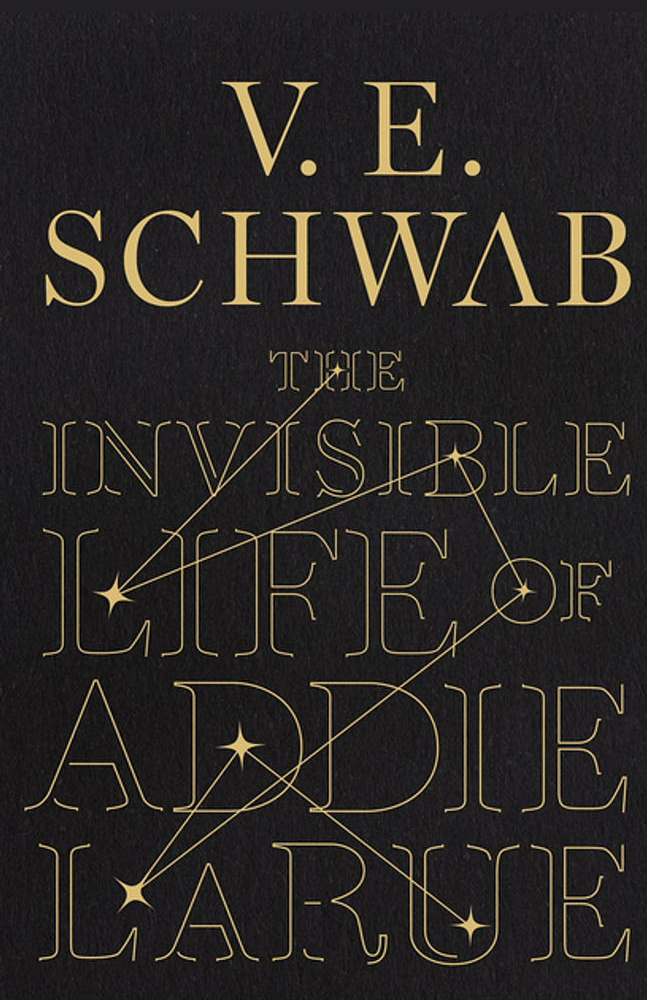Dynamic. Haunting. Mystical and eerie. “The Invisible Life of Addie LaRue” follows an immortal young woman’s journey through time, watching the world flutter by as she struggles to leave her mark. Adeline’s vague wish is granted by ancient gods that only appear at night, and soon she is cursed. To never be remembered, to never make a mark on this world.
V. E. Schwab grips the reader from start to finish. Her descriptions are stunning, lovely, and ever so unique. Schwab’s view of the world is encapsulating, and she channels it into every word on these pages. The plot is imaginative yet simple to comprehend, spectral and otherworldly yet mundane and connected to the real world. Readers are constantly thrown into different worlds and different times, yet the transitions are seamless. The novel’s non-linear progression mirrors Addie’s disjointed existence, creating a reading experience that is as disorienting as it is immersive. I time-traveled from Paris in the 1700s to New York City in 2014, each page more gripping than the last. The mythology and mystical variants of religion, the theme of old gods and veiled paganism, are altruistic and fascinating.

Addie LaRue is a deeply compelling protagonist, resilient and defiant despite her curse. Her backstory reveals a young woman trapped by the expectations of her time, desperate for freedom. This longing drives her to make a deal with Luc, the god of night, which results in her curse. Her early years, filled with rebellion against societal norms, explain her relentless fight to assert her identity and leave a mark on the world, even when no one remembers her. Her interactions with Luc, the god who cursed her, are laden with tension and complexity. Luc’s character is equally captivating, embodying the allure and danger of the darkness he represents. The motif of “My Adeline.” “I am not yours.” expresses her struggle for autonomy and identity. Addie is a female character with a personality beyond her relationships, and her cunning strategies to outwit Luc and survive through the centuries are nothing short of inspiring.
The plot is woven with intricate twists and turns, keeping the reader on edge. One of the most profound twists is when Addie meets Henry, a man who, against all odds, remembers her. This encounter is a turning point, introducing a fresh dynamic into the narrative. Henry’s own backstory, his struggles with self-worth and a deal with the same dark god, mirror Addie’s plight, creating a beautiful parallel. Their connection feels both inevitable and profound, adding to the novel’s emotional weight. Through Henry, Addie experiences a glimpse of the life she yearns for—a life where she can be seen and remembered.
The representation of Addie’s pansexuality is handled with grace, showing connections with a diverse range of people across different eras. Each relationship is distinct and beautifully crafted, reflecting the varied experiences of a woman who has lived through centuries. It’s a testament to Schwab’s skill that such a plot never feels repetitive; each encounter is fresh and impactful. These moments are brief yet profound, highlighting the fleeting nature of her interactions and the deep loneliness that accompanies her immortality.
Schwab’s descriptions of Addie’s feelings are remarkable, capturing the loneliness and longing of an existence without lasting impact. Her prose is lyrical and evocative, making readers feel every pang of isolation and every fleeting moment of connection that Addie experiences. The book delves deep into the human desire to be remembered, to leave a legacy, and it does so with heartbreaking clarity. Addie’s strategies to make her mark, from inspiring artists to leaving anonymous contributions, reveal her indomitable spirit and cleverness.
The interactions between Addie and Luc are charged with a blend of attraction and animosity. Their relationship evolves over the centuries, from adversarial to something more ambiguous. Luc’s insistence that Addie belongs to him, contrasted with her fierce declarations of independence, forms the core of their dynamic. This push and pull add layers to the narrative, keeping readers invested in their complex relationship. The power struggles between them, coupled with moments of unexpected tenderness, underscore the depth of their connection.
One of the most striking aspects of the novel is its exploration of memory and identity. Addie’s invisibility forces her to confront the essence of what it means to be human. Without a past that others can acknowledge, she becomes a ghost in her own life, yet she refuses to let this define her. Her determination to live fully, despite her curse, is both inspiring and tragic.
In conclusion, “The Invisible Life of Addie LaRue” is a brilliant exploration of memory, identity, and the desire to be remembered, all wrapped in a captivating, ethereal narrative that lingers long after the final page. I have read and re-read it and I find myself amazed each time.